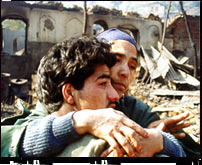There was a time not so long ago when violations emanated only from the Jammu and Kashmir police. That was in the latter half of the '80s. Then, only the police were involved in counterinsurgency. In fact, the highhandedness they exhibited is said to have pushed many youths to pick up the gun.
Then the Central Reserve Police Force and the Border Security Force came in. Kashmiris say they were like 'an army of occupation. As if they were invading Pakistan'. Whatever the truth about that claim, under Governor Jagmohan and his successor Girish Chandra Saxena, violations did increase -- a view which both governors contest.
"We were facing machine guns and Kalashnikovs and rockets, but we kept our response confined to small arms. We did not use tanks or even helicopter gunships so that civilian casualties don't increase and collateral damage is low," Saxena told rediff.com soon after he took over for a second term in 1998. "Occasionally, there were a few cases of overreaction or excess by individual members of some security force or the other. But these were aberrations."
An excuse offered for the atrocities then was that the BSF and CRPF were not trained for counterinsurgency. The former was primarily meant to defend static posts while the CRPF was for controlling riots and other policing duties. Both found the Kashmir situation very alarming.
"We were asked to fight the enemy among the people. We had no clue how to identify him. In our enthusiasm we committed several mistakes," a senior BSF official admits. "We did not realise the local population should not be alienated."
The result was incidents like the Gawakadal massacre and the firing on Mirwaiz Maulvi Farooq's funeral procession, both in 1990.
"It was not just the paramilitary forces that committed such mistakes," the BSF official continues. "Even the army did. Once a group of soldiers got alarmed on hearing a MiG-21 fighter. They opened indiscriminate fire thinking it was a bomb blast. About half a dozen civilians were killed."
The BSF's claim of no training doesn't cut any ice with Zahir-ud-din. "They had the experience of the North East to see them through," he points out. "It was not the first time they were doing anti-militancy operations."
By '92-93, both insurgency and its counter had matured. Violations too increased. But the creation of the Rashtriya Rifles, a wing of the army specially schooled in anti-militancy operations, saw soldiers approaching the situation in a more balanced way.
"But security exercises like Operation Tiger (Catch and Kill), Operation Eagle and Operation Shiva saw more killings and rape. Then the STF was formed and they took over," says Zahir-ud-din. "They are the major contributor to the present situation. Today there are less complaints against the BSF, CRPF and army."
It is not just government forces that abuse human rights. Militants do it too. The authorities point out incidents like the Sangrampura and Prankote massacres as examples.
"The Kashmiris were safe when the local youths were the backbone of the movement. But when foreign militants started taking over from, say, 94-95, there were a lot of excesses," says an official of India's foremost intelligence agency, the Research and Analysis Wing. "There was extortion, misbehaviour with women... all that alienated the locals. Now the militants have been directed by their mentors in Pakistan against such abuses."
But excesses from Indian forces continue. Maybe there are no efforts to contain it?
Chief Secretary Jaitley doesn't agree. "Our policy is very clear. We do not accept human rights abuses," he says. "Earlier the state police was inactive. Now they have become effective. That's why you are getting complaints."
Human rights lawyer Parvez Imroz contests that claim. He says violations continue because there is no transparency in the initiatives the authorities have taken.
"Personnel aren't prosecuted in an open court because it requires permission from the authorities. That hasn't been forthcoming," Imroz points out. "The army says we have punished 250 people. But what we want to know is what kind of punishment. The punishment has to be in accordance with the crime. If you are known to have raped someone and you are just suspended, that amounts to anything."
Is that all there is to it? Hear what a senior army officer says: "The Kashmiri tends to gravitate towards the stronger force. If a battalion operates aggressively, the Kashmiri invariably starts giving out information. But if a battalion is perceived as 'soft', the support for militants begins to rise. This attitude tends to attract tough conduct."
In other words, excesses will continue as long as militancy exists.
Day 8, December 17: Operation Rescue




